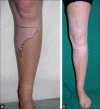Hypomelanoses in children
- PMID: 24023426
- PMCID: PMC3764650
- DOI: 10.4103/0974-2077.112665
Hypomelanoses in children
Abstract
Hypomelanosis of the skin is a frequently encountered problem in childhood, being totally innocent or representing the first sign of a multisystem disorder. Medical history, clinical examination, Wood's light investigation, histological analysis of the skin and a multidisciplinary consultation can contribute to a correct and early diagnosis of the different types of hypopigmentations. In the present paper, we present a systematic clinical approach to the differential diagnosis of those skin disorders.
Keywords: Depigmentation; Wood’s light; hypomelanosis; hypopigmentation; review; vitiligo.
Conflict of interest statement
Figures





References
-
- Tey HL. A practical classification of childhood hypopigmentation disorders. Acta Derm Venereol. 2010;90:6–11. - PubMed
-
- Gupta LK, Singhi MK. Wood’s lamp. Indian J Dermatol Venereol Leprol. 2004;70:131–5. - PubMed
-
- Scheinfeld NS. Syndromic albinism: A review of genetics and phenotypes. Dermatol Online J. 2003;9:5. - PubMed
Publication types
LinkOut - more resources
Full Text Sources
Other Literature Sources

